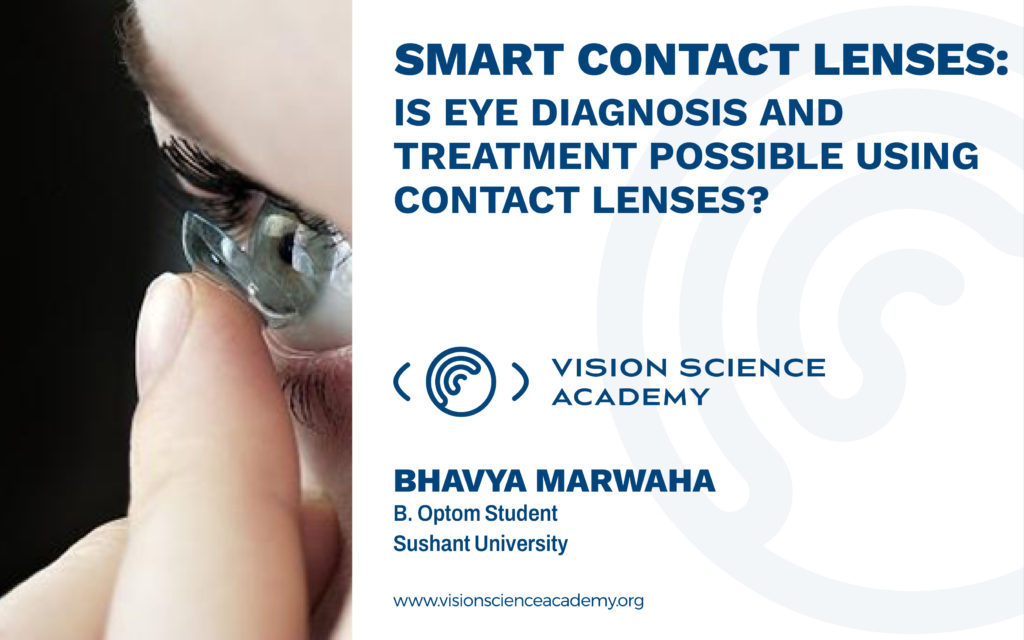Bhavya Marwaha, B.Optom
Student, Sushant University, Gurugram, India
Artificial Intelligence (AI) is defined as the science and engineering of making intelligent machines which includes usage of biosynthetic machines as a forced labour and one such invention is the smart contact lens. Now, with help of this AI Smart contact lenses are flexible and wearable medical devices which have potential for diagnosis and treatment of eye diseases. They have sensors to monitor eye characteristics including intraocular pressure and ocular fluid composition. They are helpful in providing information for diagnosis and treatment of diseases such as Glaucoma, Keratitis and Diabetes. They are useful in health monitoring and drug delivery. (1)
Figure 1: Smart Contact Lenses
[Pic courtesy – https://www.techexplorist.com/googles-new-smart-contact]
Electrical Components: (2)
- Wireless communicator: It uses radio frequency identification (RFID) technology to transmit the information collected from contact lens to the receiver. This is used for converting data format and uploading for calculation and analysis without touching the receiver. It uses a built-in antenna for data transmission hence not affecting field of view.
- Supply of power: Biochemical batteries are used to power the smart contact lenses. Moreover, chemical energy of ascorbic acid in the lacrimal fluid of human eyes converts it into electrical energy hence this can continuously power smart contact lenses without even affecting concentration of tear glucose.
- Connector and rectifier: Micro wires are used to connect electrical elements with smart contact lenses. These wires are usually made of conductive silver, which has electrical and thermal properties.
Applications:
- IOP measurement
- Glucose concentration measurement
- Measurement of lactic acid concentration
- IOP measurement (3)
Contact lens sensors monitor by measuring corneal curvature. There are multiple types of sensors for IOP monitoring. In a capacitance sensor, the corneal curvature changes with change in IOP. Hence, capacitance of IOP sensor on contact lens also changes which can be measured as the change in gap between top and bottom plate of sensors.
Glucose Concentration Measurement: (4)
This is a very important parameter in diagnosis of diabetes mellitus which may lead to diabetic retinopathy. Smart contact lens with glucose embedded sensor is used to monitor concentration of glucose in tears. Moreover, Google has designed a smart contact lens to monitor glucose concentration in the fluid of the eye. It has amazing advantages of periodic monitoring, high accuracy, comfort and many more.
Measurement Of Lactic Acid Concentration:
Lactate can be used to identify hypoxia or elevated salt concentrations due to any pathological or physiological conditions.
Drug Delivery: (5)
For effective methods of drug delivery, there is addition of customised functional groups in hydrogel matrix that produces interactions between functional groups and target drug molecules to increase drug loading in contact lenses. Contact lens-based drug delivery has various advantages, including higher efficacy, improved compliance, and fewer side effects from systemic absorption compared with eye drops.
Conclusion:
Last but not the least these smart contact lenses have shown amazing capability in biomedicine along with non-invasive diagnosis and drug delivery. These multifunctional lenses show a great impact on diagnosis of various eye diseases and even accurate analysis of eye’s response to ophthalmic drugs. This is even leading to the next generation of precise medicine-based devices.
References:
- Zhu Y, Li S, Li J, Falcone N, Cui Q, Shah S, Hartel MC, Yu N, Young P, de Barros NR, Wu Z. Lab‐on‐a‐Contact Lens: Recent Advances and Future Opportunities in Diagnostics and Therapeutics. Advanced Materials. 2022 Jun;34(24):2108389.
- Ku M, Kim J, Won JE, Kang W, Park YG, Park J, Lee JH, Cheon J, Lee HH, Park JU. Smart, soft contact lens for wireless immunosensing of cortisol. Science advances. 2020 Jul 8;6(28):eabb2891.
- Chen GZ, Chan IS, Leung LK, Lam DC. Soft wearable contact lens sensor for continuous intraocular pressure monitoring. Medical engineering & physics. 2014 Sep 1;36(9):1134-9.
- Park J, Kim J, Kim SY, Cheong WH, Jang J, Park YG, Na K, Kim YT, Heo JH, Lee CY, Lee JH. Soft, smart contact lenses with integrations of wireless circuits, glucose sensors, and displays. Science advances. 2018 Jan 24;4(1):eaap9841.
- Ciolino JB, Dohlman CH, Kohane DS. Contact lenses for drug delivery. InSeminars in ophthalmology 2009 Jan 1 (Vol. 24, No. 3, pp. 156-160). Taylor & Francis.
